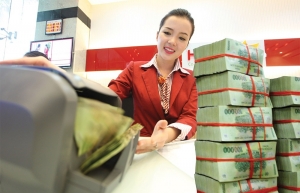Resilience playing part in Vietnam’s 2024 performance
The Vietnamese economy is expected to have grown above 7 per cent in 2024. How do you assess this performance?
 |
| Andrea Coppola, lead country economist and programme leader for Equitable Growth, Finance and Institutions at the World Bank in Vietnam, Cambodia, and Laos |
Vietnam’s economic performance in 2024 has been remarkably strong. Despite grappling with international geopolitical tensions and the looming threats of climate change and natural disasters, the nation has shown impressive resilience. In 2024, Vietnam’s economy not only sustained its long-term developed trajectory but also achieved the fastest growth rates in East Asia.
This success is largely attributed to a surge in external demand, which boosted exports and industrial production, alongside a steady recovery in domestic demand. Looking ahead, this positive momentum is expected to carry into 2025. Our latest economic forecasts point that Vietnam will grow at a rate of about 6.5 per cent in 2025, which would position the country once again among the fastest growing economies at the regional and global level.
Could you evaluate the effectiveness of the government’s monetary and fiscal policy mix?
In 2024, authorities successfully leveraged monetary and fiscal policy instruments to maintain macroeconomic stability while supporting the gradual recovery of domestic demand. I would also like to congratulate the authorities for the continuous efforts to strengthen the business environment by simplifying regulations, which is key to promoting the development of the Vietnamese private sector.
A comprehensive package of coordinated policies is needed to effectively support a faster and sustainable growth path for the Vietnamese economy. Accelerating disbursement of public investment would support aggregate demand in the short run, while also helping to close emerging infrastructure gaps.
On the other hand, monetary authorities may have limited room for additional interest rate cuts due to the possible appreciation of the dollar that may materialise during the next months.
Building on recent reforms, further steps to mitigate financial sector risks and vulnerabilities remain important.
The authorities could encourage banks to improve capital adequacy ratios and strengthen the institutional framework for prudential supervision and early interventions, to promptly address emerging challenges.
Developing capital markets is also crucial for supporting long-term economic growth by ensuring a stable, efficient, and accessible financial environment. One key challenge for capital markets development is the underdevelopment of the institutional investor base. A gradual diversification of Vietnam Social Security investments could help to support capital markets development.
Authorities could accelerate structural reforms to strengthen the regulatory environment in critical backbone services such as ICT, electricity, and transport to green the economy, build human capital, and continue improving the business environment. Further trade diversification and deepening regional trade integration and connectivity will also reduce exposure to global trade fragmentation and ensure resilient growth.
The government envisions a double-digit GDP growth rate in 2025 through many solutions including institutional reforms. What are the major institutional bottlenecks that Vietnam should prioritise removing?
Vietnam has been making progress in improving institutions for many years, but additional reforms are needed to facilitate the country’s development and the achievement of high-income status by 2045. Vietnam’s decision-making system is consensus-based, and this has many positive features. It helps avoid overly hasty decisions. But it can also slow decision-making even for cases where the need for change is clear. In order to improve state capability to be more efficient and nimbler, Vietnam may need to be more selective in how it intervenes in the economy. The request to abandon the “if you can’t manage it, then ban it” mindset is an essential innovation.
Moving from a prohibition to a facilitation mindset will help to reduce the number of unnecessary regulations and promote innovation, creativity, and efficiency. A flexible management mindset that fosters development will inspire agencies and civil servants to actively pursue new solutions.
Moreover, a more selective approach will ultimately mean doing less of many things, and the size of the state apparatus could shrink, which could also create efficiency savings while allowing the compensation in the public sector to catch up to that of the private sector. It is important to ensure that civil servants and public servants are compensated well to attract and retain talent.
Although frequent government reorganisations may be counterproductive, periodic realignments to address emerging needs and to fix known inefficiencies, like duplicative functions and misaligned incentives, are important. The present effort of the government to do such a realignment is a positive step forward.
Finally, we often hear about challenges with public investment management, and it is good to see that many weaknesses have been addressed through the revisions to the Public Investment Law..
What is your expectation on Vietnam’s trade landscape next year?
The importance of global trade for Vietnam’s development cannot be overstated. Vietnam has one of the highest degrees of trade integration in the world. It has a wide network of trade agreements covering 53 countries, accounting for almost 90 per cent of the world’s GDP. In this context, the evolution of the trade landscape poses key opportunities for Vietnam but also challenges that need to be carefully managed.
Firstly, increasing automation has possible implications on jobs and competitiveness, especially for countries that rely on an export model based on low labour costs and labour-intensive exports like Vietnam.
Secondly, climate change and the green transition require stepping up efforts to reduce Vietnam’s vulnerability to natural disasters and reducing the carbon intensity of Vietnamese production to remain competitive at the global level in a context in which international consumers and investors pay increasing attention to green products and green investment opportunities.
Thirdly, global demand is gradually shifting towards Asia. Despite the relatively high propensity to save, consumer spending in East Asia is growing fast, while it is declining in the US and in Europe. Increasing demand from Asian countries is an important opportunity that Vietnam will need to seize.
The World Bank has launched the report called Vietnam 2045. The report explores how the country can navigate the evolving global trading system and leverage the next phase of global and regional integration to achieve its aspiration of becoming a high-income economy in the next 20 years.
It proposes a set of complementary policy recommendations including transitioning from labour-intensive final assembly to skill- and technology-intensive high-value activities, deepening regional trade integration by reducing non-tariff policy barriers, developing the workforce for high-technology industries, strengthening the linkages between domestic firms and global value chains, and promoting low-carbon and climate-resilient exports.
 | Vietnam's e-commerce market surpasses $25 billion in 2024 Vietnam's e-commerce market exceeded $25 billion in 2024, an increase of 20 per cent on-year, according to the Ministry of Industry and Trade (MoIT). |
 | Impressive growth can be built upon By weathering various difficulties, Vietnam is expecting to see higher economic growth. Paulo Medas, division chief and mission chief for Vietnam, and Fei Han, senior economist at the International Monetary Fund, provide analysis over how to sustain the country’s strong growth performance in the medium term. |
 | Strategy outlined for growth goals The government is to maximise all possible resources in the economy and from external financial assistance in an aim to achieve a fresh economic growth goal for 2025. |
What the stars mean:
★ Poor ★ ★ Promising ★★★ Good ★★★★ Very good ★★★★★ Exceptional
Related Contents
Latest News
More News
- Pivotal stage of growth paves way for rise in M&As (December 03, 2025 | 10:00)
- Positive projections for M&A interest from Thailand (December 03, 2025 | 09:40)
- Manifesting the first line of defence in cybersecurity (December 03, 2025 | 09:00)
- The transformational role AI can play in accounting arena (December 03, 2025 | 08:00)
- Unlocking 5G-AI potential in Singapore (December 03, 2025 | 08:00)
- Data-driven strategies vital for a fast-evolving nation (December 02, 2025 | 09:41)
- Policy to practice: how Vietnam can lead the region (November 26, 2025 | 16:03)
- Mobilising private capital at scale vital for climate battle (November 26, 2025 | 15:36)
- VILAF and Yoon & Yang launch Vietnam - Korea Practice Unit (November 26, 2025 | 15:16)
- Trademark disputes challenge foreign firms in Vietnam (November 24, 2025 | 15:30)

 Tag:
Tag:





















 Mobile Version
Mobile Version